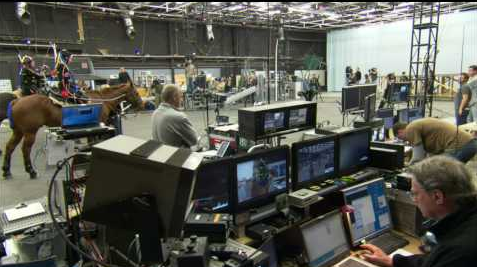Artificial Worlds and the Cinema
 Monday, November 15, 2010 at 1:34PM
Monday, November 15, 2010 at 1:34PM  On the set of Avatar
On the set of Avatar
The cinema was dominated for a hundred years by a certain kind of theatricality, mise-en-scene, in which a set or a scene, something visible, determined the structure of shots and the actor’s role in them and most importantly the director’s creative vista. Now the actor and the director must imagine the scene they are in to a far greater degree than ever before, which is why production processes like pre-visualization and post-production have become so important.
In the literal sense there is now no scene. There is nothing scenic about a green or blue wall onto which images and events, backgrounds and foregrounds will later be digitally grafted or a motion capture studio where everything happens in complete abstraction from reality. Rather, to be in a scene in the digital cinema is to enter into an imaginary wonderland, a Narnia of the mind, a fantasy upon which and through which actors produce their roles. As in the past, they have to produce themselves as characters but within a carefully constructed space that is existentially artificial and quite bereft of physical markers. In a sense, because special effects are so important to the cinema in the 21st century, the process of production is more akin the creation of animated films which is why the cinema is now a hybrid or mixed medium.
This is why the contemporary documentary cinema is so wildly popular. Throughout the 20th century, documentaries were of marginal value to the film business and generally viewed by small audiences with specialized interests. This has changed completely. I attribute the shift to the need to capture events and people with some spontaneity and to produce meaning by engaging with the world — the lens as window without the interference of special effects.
Artifice is of course foundational to all genres of cinema. There is a young character by the name of Lucy in the film of The Lion, the Witch and the Wardrobe. Her role is central to the narrative, especially in the beginning when she discovers Narnia, a winter wonderland of snow and extraordinary creatures. In order to make sure that her reaction to the “scene” would be as innocent and as open as possible, the creators of the film kept her away from the set until they needed to film her shots. Then they blindfolded her and brought her into the studio. She still only saw a fragment of the final version of the environment that had been created for the film — heavily composited, reshaped through a variety of sophisticated tools and technologies — but the director wanted her to look as if she had never seen what the filmmakers had created. They needed her innocence to be as genuine as possible in order to bring some authenticity to the shot, as if they were afraid of the artifice of the special effects. This is the challenge generated by creative processes that move from screen to screen until they finally make it to the big (film or television) screen.
A series of phantoms, images that barely exist outside of the computer, scenes that are not built by actors but by the agile use of technology, all of this adds up to an imaginary world, one that is generated by the use of technologies that have transformed the production process.
An imaginary scene built upon the imagination of viewers, this doubles the effects of identification and viewing and perhaps explains why the movie Avatar was such a success. The director, James Cameron realized that in order to convey the intensity of the world that he had created for his actors, he had to actually play back each scene to them. As much time as possible was spent witnessing the artificial world of Pandora as managing the complexity of acting within the confines of a studio.
Ironically, this is precisely what viewers have to grapple with while watching the film. They have to enter a world they know is artificial, believe in its geography and physicality and struggle with the knowledge that the world only exists in their imaginations. They are imitating the struggle of the actors who have to devise all sorts of ways of legitimizing their roles within non-existent spaces.
Artifice, audience and imagination have merged.


